This is a map of the AT&T microwave relay system as it was in 1960. It is interesting for several reasons. First of all, before there were communications satellites, this is the way that data was transferred from one location to another. That data would have been digitized and TDM encoded on a T-carrier, then loaded onto a microwave path. TV networks had loops that transversed the country, distributing network video and audio to all the markets in the US. The first transcontinental New York to San Francisco microwave route was established in 1951. Through the fifties and sixties, the network was filled in across the US and Canada.
Radio networks had been using wired TELCO networks for program distribution for years, although they required far less bandwidth than TV. This was during the time when network affiliation was vitally important to a station. Radio networks provided news and other special event programming, as well as some long-form shows which were an important source of information for the listeners. Any network programming prior to 1980 or so would have been carried by this system.
It was not until the use of C and Ku band satellite services that networks could offer multiple channels of programming. Now, entire radio formats could be programmed remotely and beamed into hundreds of stations across the country simultaneously. That would have been far too expensive to implement over TELCO lines, as the line charges were based on the mileage of the circuit.
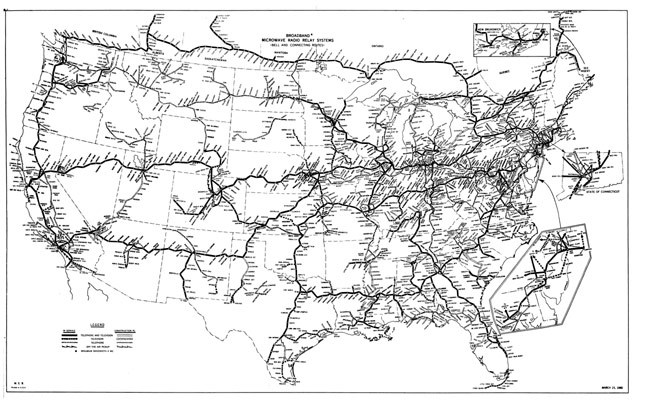
Click for higher resolution.
This system included thousands of hardened microwave relay sites, each built to exact specifications and fully redundant. At the time, the long-distance telephone system was an integral part of the US defense planning. Sites were spaced 20-40 miles apart, depending on terrain. In congested areas, like the northeast, area mountain tops are dotted with these sites today, mostly empty. Most of these sites went offline in the late 1990s as phone companies switched to fiber optic cables for telephone and data traffic.
American Tower, Inc. purchased most of these sites in bulk from AT&T in the year 2000. Some sites are well positioned for Cellular Telephone, 3G, and 4G wireless data services, plus other things like Media Flow and general use applications like FM broadcast and two-way. Many sites, however, do not meet any specific needs and sit empty. There was a large fire sale by American Tower in 2002 in which they unloaded about 1,900 of these sites as they were redundant.
I wrote a post titled Cold War Relic: ATT long lines site, Kingston,NY detailing one of these sites near me. Keep in mind, there were thousands of these sites throughout the country.


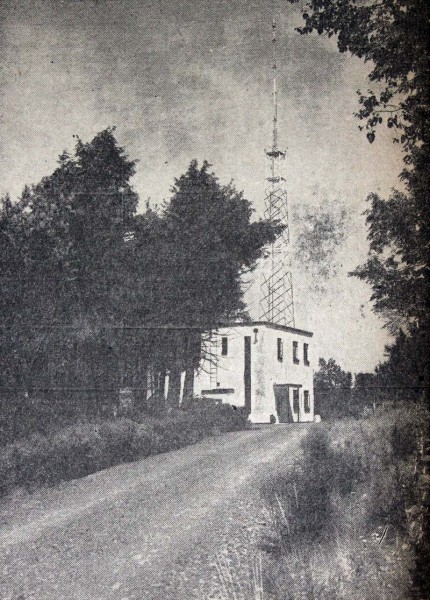
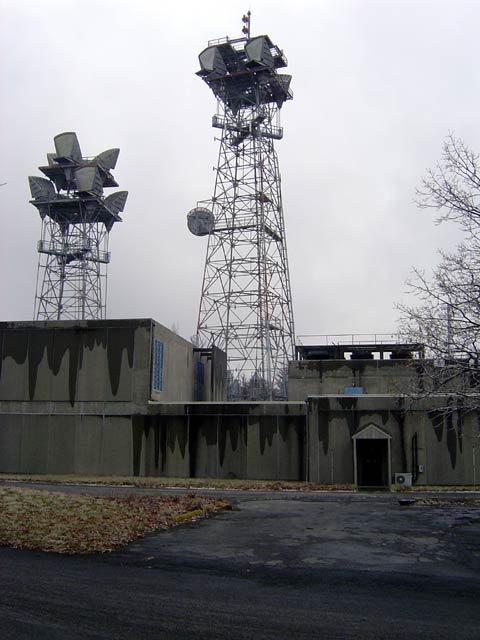
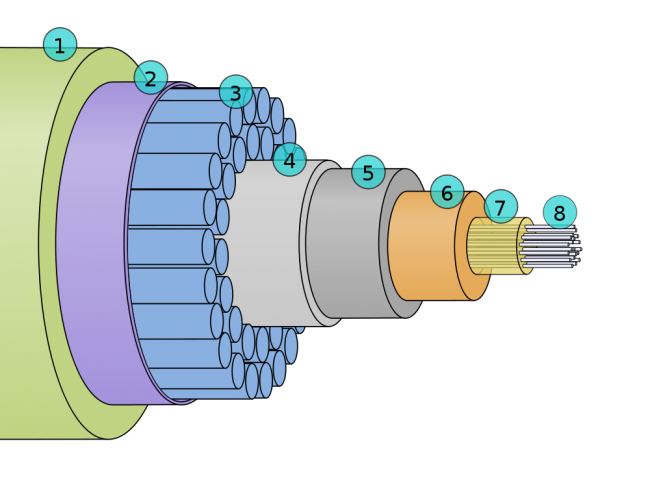
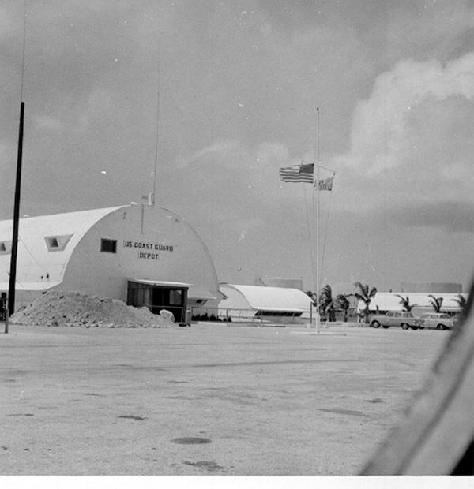
Actually, 1967 sites were purchased by ATC in 1998 from AT&T. The “fire sale” in 2001 and 2002 was do to huge tax assessments and bills that carried over on the properties and became burdensome to ATC. Municipal assessors had sky high assessments on these properties, and AT&T almost never contested an assessment. It was just too much for ATC to sustain, and non-productive sites had to be disposed of. The number was probably around 300 that were sold. In 1988, AT&T had about 250,000 employees, and the goal was a cutback to 100,000. Generous 5-year severance packages were offered to supervisory personnel when the de-commissioning of the trans-con microwave network network began a year later. The fiber-optic network was being built near metro areas throughout the late ’80’s, and continues today. The huge bandwidth obtained with this technology, along with low noise and immense cost savings in maintenance personnel and other operational expenses dictated the cold war era radio relay sites to be dumped. These days, Wireless Internet entrepreneurs are busy making use of many of these sites for point-to-point transport and distribution to their customers in areas where there are poor facilities to transport high-speed Internet traffic. As long as there is wireless, there will always be a need for transmission towers. “The cord is invisible, dad”!
Is there really one called Anarchist in British Columbia?
I seems there is. In my trips up north, I have found our Canadian neighbors have a sense of humor when naming their locations. One such place, where my wife’s family comes from was formerly called “Bastard Township,” since renamed Rideau Lakes township. Anyway…
Actually, doing some research – here it is! http://en.wikipedia.org/wiki/Anarchist_Mountain
This helps explain why during my time in the USN in the late 1980’s phone calls home could range around 3 bucks a minute! The infrastructure costs for this system had to be HUGE!
There was no T1 in 1960; it came into being in 1962. The microwave and coax networks were analog multiplexed; look up terms “FDM” “supergroup” and “jumbogroup”. The coax carried ~50 Khz->40 Mhz and coast to coast, needed 1000 db of gain. The microwave needed less active gain as the horns had insane gain at the higher frequencies.
The above map predates TDM and digitization. Early implementations of the wireless technology started as “TD-2”, FM microwave on 4, 6, and 11GHz and moved to SSB/AM with the introduction of AR6A. AR6A was the last analog microwave system. The digital microwave systems followed after that with the DR6, DR10, and so on.
Other names of the systems were TD-3, TH, TH-3, TJ, TM, and so on.
See also: http://www3.alcatel-lucent.com/bstj/
The TD-2 sites in Canada operated from 1956 by Eastern Tel and Tel, purchased by the Provincial Telcos in 1978 and shut down in the early 1980’s. Some of the towers are still standing.
My Microwave Engineering days on TD 2 , TH1 , AR6 (a bell Labs single sideband system) TL, TM, TJ TH3, TD3, and then the ancilliary equipment to switch it all and have a way to restore from a remote location, kept me busy from 1967 thru almost 1985 when I was promoted and moved on to Kanasa City from St. Louis.
The crew of people it took to just maintain 5 states from an engineering standpoint took 3 engineering departments, Microwave Engineering, Power, and office facility planning and cabling.
The Microwave engineer, had overall responsibility to assure the Microwave portion was engineered properly and also assured Power and Cabling was done by the other departments.
AT&T basically had us to long Haul and the Bell company had us to short haul, and the Bell companies did not stick with Western Electric product, There was Lenkurt and Farinon, Raytheon digital, as well as Collins digital Radio. And for us Western Electric engineers, not much in the way of training on outside vendor product.
Along with the above AT&T radio, at main stations, the radio (for some channels) was just patched straight thru the office and others were dropped down to Broadband, and then further broken down to channel banks and individual circuits at a central office. At the time, Communications for public Broadcasting (CPB) all video was transmitted over TD2 systems. And there was also channels used for Commercial TV with all kinds of timed switching. And Engineering had to be done to allow all this video to be switched to various locations depending upon Television needs in many areas. CPB eventually moved to something else and so did commercial TV and those channels that had been dedicated were either retired or put to use for message circuits. A message circuit route, as I remember could be 12 individual radio channels, (11 working, 1 protection) and each of the 11 could carry 1500 circuits each or be used for one video channel.